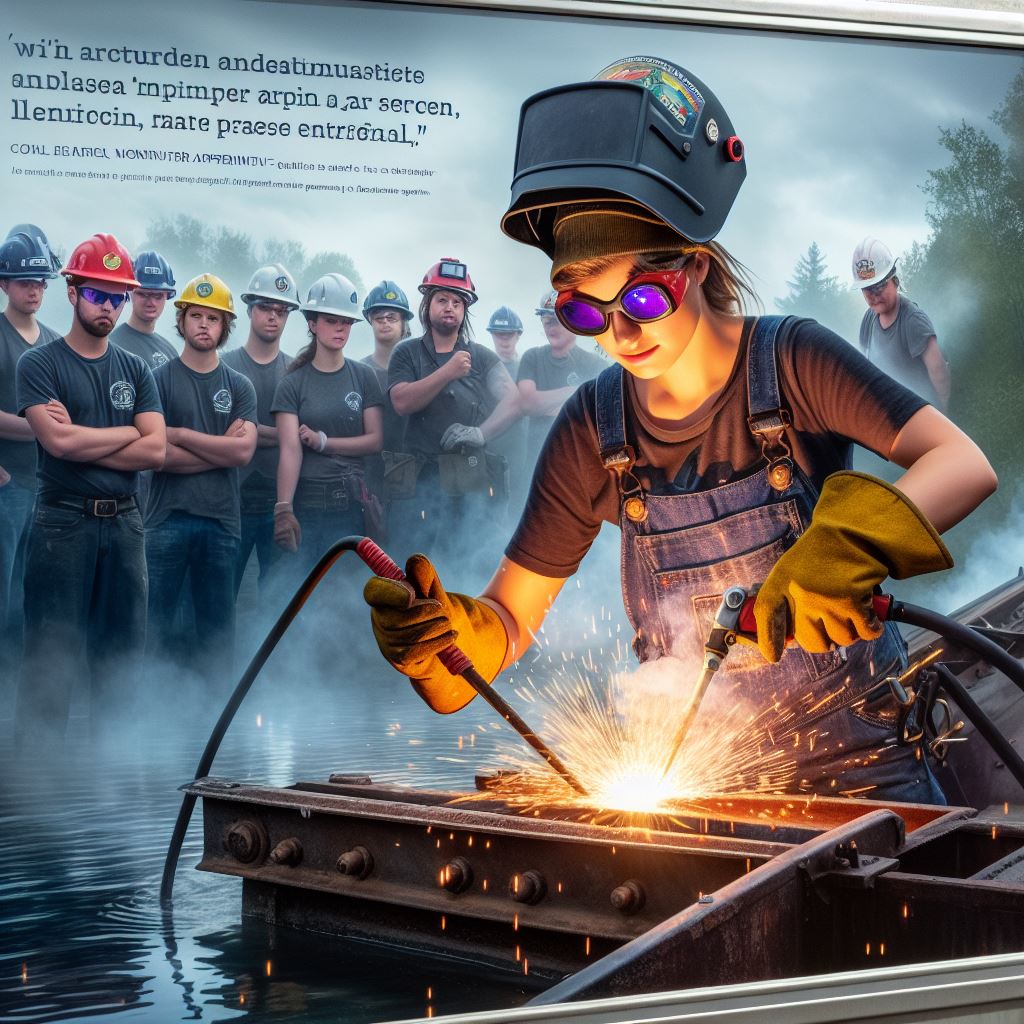Introduction
Safety standards are of utmost importance in the construction industry as they protect workers and prevent accidents.
Ensuring safety standards in construction is crucial as it reduces the risk of injuries and fatalities on worksites.
Mentioning Canada’s reputation for strong safety regulations in various industries
Canada is renowned for its robust safety regulations, which extend to various industries, including construction.
The Canadian government prioritizes the well-being of workers, mandating safety measures and inspections to maintain high standards.
The strict adherence to safety regulations in construction has garnered Canada international recognition and praise.
Employers in Canada must provide a safe work environment and adhere to safety standards to protect their employees.
Canadian construction sites adhere to strict safety protocols, including proper training, hazard assessment, and the use of protective equipment.
These safety standards ensure a high level of safety on construction sites, reducing the risk of accidents and injuries.
The dedication to safety standards has helped Canada maintain a positive reputation and attract international investments.
In short, safety standards in Canada’s construction industry are crucial for protecting workers and maintaining a positive reputation.
The country’s commitment to enforcing safety regulations has made it a global leader in ensuring workplace safety.
Overview of Safety Standards
Canada’s construction industry follows stringent safety standards to ensure the well-being of workers and minimize accidents on construction sites.
These standards are put in place by regulatory bodies and governed by legislative documents that enforce compliance.
The Key Regulatory Bodies
Several regulatory bodies have been established in Canada to oversee and enforce safety standards in the construction industry.
These bodies include:
- Occupational Health and Safety (OHS) Authorities: Each province and territory has its own OHS authority responsible for workplace safety regulations. They conduct inspections, issue licenses, and enforce compliance.
- Canadian Centre for Occupational Health and Safety (CCOHS): This federal agency provides information, tools, and resources to promote health and safety in the workplace. It conducts research, offers training programs, and develops guidelines for better safety practices.
- Workplace Safety and Insurance Board (WSIB): This organization administers Ontario’s workplace safety and insurance system. It provides financial assistance to injured workers and helps employers create safe working environments.
- Construction Safety Association of Ontario (CSAO): Focused specifically on construction safety, CSAO provides training, consulting, and resources to improve safety practices in the construction industry.
The Main Legislative Document
The main legislative document governing construction safety standards in Canada is the Occupational Health and Safety Act (OHSA).
This Act lays out the rights and responsibilities of employers, supervisors, and workers to ensure a safe working environment.
Under the OHSA, employers are obligated to provide:
- Safe equipment and machinery: Employers must ensure that all equipment and machinery used on construction sites meet safety standards and are maintained properly.
- Safety training and supervision: Employers must provide comprehensive training programs and designate competent supervisors to oversee construction activities and enforce safety protocols.
- Protective gear and clothing: Employers must supply workers with appropriate personal protective equipment (PPE), including hard hats, safety glasses, gloves, and steel-toed boots.
- Hazard identification and reporting procedures: Employers are required to implement systems for identifying and reporting potential hazards on construction sites, allowing for timely preventive measures.
Workers are responsible for following safety guidelines, attending training programs, and reporting any unsafe conditions they observe.
Employees have the right to refuse work that they believe is dangerous or fails to meet safety standards.
Violations of safety standards can result in severe penalties, including fines and potential legal action.
Employers and supervisors must ensure compliance with all applicable regulations to protect their workers and prevent accidents that could lead to injuries or loss of life.
In fact, safety standards in Canada’s construction industry are strictly regulated and enforced by various bodies.
The OHSA serves as the primary legislative document, outlining the obligations of employers and workers to create a safe working environment.
Unlock Your Career Potential
Visualize a clear path to success with our tailored Career Consulting service. Personalized insights in just 1-3 days.
Get StartedBy adhering to these standards, construction companies can mitigate risks, protect their workforce, and contribute to a safer and healthier industry as a whole.
Read: Electrician Salary Ranges in Canada’s Provinces
The Evolution of Safety Standards in Canada’s Construction Industry
The Canadian construction industry has come a long way in terms of safety standards.
Over the years, comprehensive safety regulations have been developed to ensure the well-being of workers and prevent accidents.
Understanding the historical context that led to these standards is crucial in appreciating the progress made in construction safety in Canada.
Historical Context
- In the early years of Canada’s construction industry, safety standards were virtually nonexistent.
- Workers were exposed to hazardous conditions, and accidents were alarmingly common.
- Increased awareness of worker rights and the advocacy for safer working conditions led to the gradual development of safety regulations.
- The establishment of labor unions played a significant role in championing for improved safety measures.
- Legal frameworks began to emerge, emphasizing the responsibility of employers to ensure a safe working environment.
Prompting Incidents and Accidents
Several significant incidents and accidents have further accelerated the development of safety regulations in Canada’s construction industry.
- The Quebec Bridge collapse of 1907 resulted in the death of 86 workers, highlighting the need for better engineering practices and safety protocols.
- The Westray Mine disaster in 1992 claimed the lives of 26 miners due to inadequate safety measures and negligent management.
- These tragic events became catalysts for stricter safety regulations in the construction industry.
- Building collapses, inadequate scaffolding, and electrocution incidents reinforced the urgency for comprehensive safety standards.
- The increasing number of workplace injuries and fatalities necessitated a proactive approach towards minimizing risks.
Development of Comprehensive Safety Standards
Due to these incidents and the growing recognition of the importance of safety, Canada’s construction industry has implemented various measures to ensure the well-being of its workforce.
- Government regulations have been formulated to enforce safety practices on construction sites.
- Worker safety training programs and certifications have become mandatory for construction personnel.
- Inspectors are now regularly monitoring construction sites to ensure compliance with safety standards.
- Collaborations between industry associations, unions, and government entities aim to continuously improve safety measures.
Today, safety helmets, protective gear, and safety protocols are commonplace on construction sites across Canada.
The evolution of safety standards has undoubtedly resulted in a safer work environment for construction workers.
The progress made in safety standards within Canada’s construction industry is a testament to the collective effort of various stakeholders.
From the early years of neglecting safety to the current comprehensive regulations, the industry has come a long way.
However, continuous improvements, awareness, and adherence to safety standards are essential for ensuring the well-being and lives of construction workers.
Read: Electrician Certifications in Canada: A Guide
Key safety standards and requirements
In Canada, construction companies must adhere to a set of important safety standards and requirements in order to ensure the well-being and protection of workers.
These standards cover various aspects of safety, including personal protective equipment (PPE), fall protection, hazard assessments, and emergency preparedness.
Personal Protective Equipment (PPE)
- Construction workers are required to wear appropriate PPE such as helmets, safety glasses, and protective footwear.
- Gloves are essential for protecting hands from cuts, burns, and chemical exposure.
- High visibility clothing is mandatory to increase visibility and prevent accidents.
Fall Protection
- Construction companies must have fall protection measures in place to prevent falls from heights.
- Workers above certain heights are required to use safety harnesses and lifelines.
- Scaffolding and ladders should be inspected regularly to ensure they meet safety regulations.
Hazard Assessments
- Construction sites must conduct hazard assessments to identify potential risks and hazards.
- Regular inspections should be conducted to monitor and mitigate identified hazards.
- Workers should receive proper training on identifying and responding to hazards.
Emergency Preparedness
- Construction companies should have emergency response plans in place for various scenarios.
- Workers should be trained on emergency procedures and evacuation routes.
- First aid kits, fire extinguishers, and emergency contact information should be readily available on-site.
By adhering to these safety standards and requirements, construction companies can help create a safer working environment for their employees.
It also helps to minimize accidents, injuries, and potential legal liabilities.
It’s important for companies to continually review and update their safety protocols to stay in line with any changes in regulations or industry best practices.
Regular training sessions and communication channels should be established to ensure that all workers are aware of the safety standards and requirements in place.
Additionally, construction companies should foster a culture of safety by encouraging workers to report any safety concerns or near-miss incidents.
Encouraging a proactive safety approach empowers workers to actively contribute to a secure workplace environment.
In essence, safety standards and requirements play a crucial role in the construction industry in Canada.
Construction companies must prioritize the well-being and protection of their workers by adhering to standards related to personal protective equipment, fall protection, hazard assessments, and emergency preparedness.
By doing so, they create a safer working environment and minimize the risk of accidents and injuries.
Read: A Day in the Life of a Canadian Electrician

Role of government and industry associations
The Role of Government and Industry Associations in Ensuring Safety Standards in Canada’s Construction Industry
Ensuring safety standards in the construction industry is crucial to protect workers and prevent accidents.
Both the government and industry associations play a significant role in establishing and enforcing these standards.
This blog section will discuss the government’s role in enforcing safety standards and inspecting construction sites, as well as highlight the efforts of industry associations in promoting and improving construction safety.
Government’s Role in Enforcing Safety Standards
- Legislative Framework: The government creates laws and regulations that establish safety standards for construction sites.
- Health and Safety Inspections: Government agencies conduct regular inspections to ensure compliance with safety regulations.
- Penalties and Fines: The government has the authority to impose penalties and fines on non-compliant construction companies to enforce safety standards effectively.
- Worker Training Programs: The government invests in training programs to educate construction workers about safety practices and regulations.
- Collaboration with Industry: The government collaborates with industry stakeholders to develop and improve safety standards continually.
Government’s Role in Inspecting Construction Sites
- Site Inspections: Government inspectors visit construction sites to assess compliance with safety regulations.
- Hazard Identification: Inspectors identify potential hazards, such as faulty equipment or unsafe work procedures.
- Corrective Measures: Inspectors enforce corrective measures, ensuring that any identified hazards are addressed promptly.
- Documentation: The government maintains detailed records of inspections, ensuring accountability and transparency.
Efforts of Industry Associations in Promoting Construction Safety
- Development of Standards: Industry associations actively participate in the development of safety standards, aiming to improve construction safety.
- Training and Education: Associations offer training programs and resources to educate construction workers and employers about safety practices.
- Resource Sharing: Industry associations facilitate the exchange of best practices and safety information among their members.
- Advocacy: Associations advocate for the inclusion of safety measures in construction projects, emphasizing the importance of prioritizing worker safety.
- Research and Innovation: Industry associations invest in research to identify new technologies and approaches that enhance construction site safety.
The government’s role in enforcing safety standards and inspecting construction sites is crucial, as it establishes regulations and ensures compliance through inspections.
On the other hand, industry associations play a valuable role in promoting and improving construction safety by actively participating in the development of standards, offering training programs, and advocating for worker safety.
The collaboration between the government and industry associations is essential for maintaining a safe working environment in Canada’s construction industry.
Read: Welding Tools and Equipment: A Beginner’s Guide
Training and Certification Programs
Training and certification programs play a vital role in guaranteeing compliance with safety standards in Canada’s construction industry.
These programs provide workers with the necessary knowledge and skills to carry out their tasks safely and effectively.
Recognized training programs and certifications are available to equip construction workers with the required expertise and ensure workplace safety.
Let’s explore their significance and the options available:
Importance of Training and Certification Programs
- Enhancing Safety Awareness: Training programs raise awareness about potential hazards, safety protocols, and best practices, reducing the risk of accidents.
- Skills Development: These programs equip workers with skills and knowledge to handle tools, machinery, and work in hazardous environments correctly.
- Compliance with Regulations: Certification ensures that workers adhere to current safety standards and regulations set by government bodies.
- Minimizing Accidents: Properly trained workers are less likely to cause accidents, injuries, or fatalities, creating a safer work environment for everyone.
- Legal Liability Reduction: Compliance with safety standards through training and certification can protect employers from potential legal liabilities.
Recognized Training Programs and Certifications
- Construction Safety Association of Ontario (CSAO): This organization offers a variety of training programs, including the Construction Health and Safety Training Program (CHSTP).
- Canadian Centre for Occupational Health and Safety (CCOHS): CCOHS provides numerous courses, such as the Basic Certification for Construction Health and Safety Professionals (CHSP).
- Infrastructure Health and Safety Association (IHSA): IHSA offers training programs, such as Working at Heights, Traffic Control, and Joint Health and Safety Certification.
- Safety Services Nova Scotia (SSNS): SSNS provides certifications like Construction Safety Supervisor (CSS) and Construction Safety Coordinator (CSC).
- Canadian Construction Association (CCA): CCA offers the Gold Seal Certification, which recognizes experienced construction industry professionals.
- Workplace Safety and Prevention Services (WSPS): WSPS delivers various training programs, including Construction Supervisor Awareness and Skills, and Safety Representative.
It’s essential for construction companies and workers to choose training programs and certifications that align with their specific job responsibilities and industry requirements.
Employers should prioritize providing comprehensive training to employees, ensuring they acquire the necessary skills and knowledge to maintain safety on construction sites.
In general, training and certification programs have a significant impact on ensuring compliance with safety standards in Canada’s construction industry.
By enhancing safety awareness, developing skills, and promoting adherence to regulations, these programs create a safer and more efficient work environment.
Construction workers and employers must prioritize participation in recognized training programs to protect themselves and reduce the risk of accidents.
Ongoing challenges and improvements
The construction industry in Canada faces ongoing challenges in maintaining compliance with safety standards.
The industry’s dynamic nature, constantly evolving and introducing new risks, exacerbates these challenges.
However, there are continuous efforts to improve safety standards through the use of technology, research, and innovation.
Ongoing Challenges in Maintaining Compliance with Safety Standards
- The construction sector features ever-evolving work settings and conditions.
- Ensuring compliance with safety standards becomes challenging due to the diverse range of construction projects.
- The industry faces difficulties in keeping up with rapidly evolving safety regulations and codes.
- Managing the diverse workforce with varying levels of training and experience poses a challenge.
- Strict project deadlines and budget constraints sometimes prioritize productivity over safety.
- The increasing complexity of construction projects introduces new risks and potential safety hazards.
- Communication gaps between different stakeholders can lead to a lack of clarity regarding safety requirements.
- Effective implementation of safety protocols and monitoring systems is a constant challenge for employers.
- External factors like extreme weather conditions and geographic challenges can affect safety on construction sites.
- The industry’s high turnover rate and labor shortage affect the consistency of safety training and practices.
Ongoing Efforts to Improve Safety Standards
- Technology plays a crucial role in improving safety standards in the construction industry.
- Advanced safety equipment and wearable devices help monitor workers and prevent accidents.
- Building Information Modeling (BIM) enables better safety planning and risk assessment before construction begins.
- Research and data analysis contribute to identifying potential hazards and improving safety measures.
- The industry invests in continuous education and training programs to enhance safety knowledge and skills.
- Collaborative efforts between industry stakeholders and regulatory bodies help align safety standards.
- Innovation in construction practices aims to reduce risks and enhance overall worker safety.
- Implementation of safety management software facilitates better tracking and reporting of safety-related incidents.
- Incentives and recognition programs encourage best safety practices among construction companies.
- Regular site inspections by regulatory authorities help enforce compliance with safety standards.
In a nutshell, maintaining compliance with safety standards in Canada’s construction industry is a continuous challenge.
However, ongoing efforts to improve these standards through technology, research, and innovation are enabling strides in worker safety.
As the industry continues to evolve, it is vital to prioritize safety and ensure that all stakeholders work together to create a safe and secure work environment.
Conclusion
The significance of safety standards in Canada’s construction sector cannot be emphasized enough.
Adherence to these regulations is crucial to protect workers and create a safe working environment.
Employers must prioritize safety, embedding it in their culture for sustained success.
The cost of neglecting standards is immeasurable; it’s not just financial but human.
We cannot underestimate the value of a vigilant workforce, where everyone actively contributes to a secure workplace.
Regulations evolve, demanding perpetual vigilance. Embrace change, stay informed, and implement updates promptly.
Training programs must align with the latest standards, fostering a dynamic safety culture.
Routine inspections are not just bureaucratic; they are life-saving tools.
A safe environment isn’t a one-time achievement—it’s an ongoing commitment to protect workers, uphold integrity, and fortify the construction industry’s foundation.




